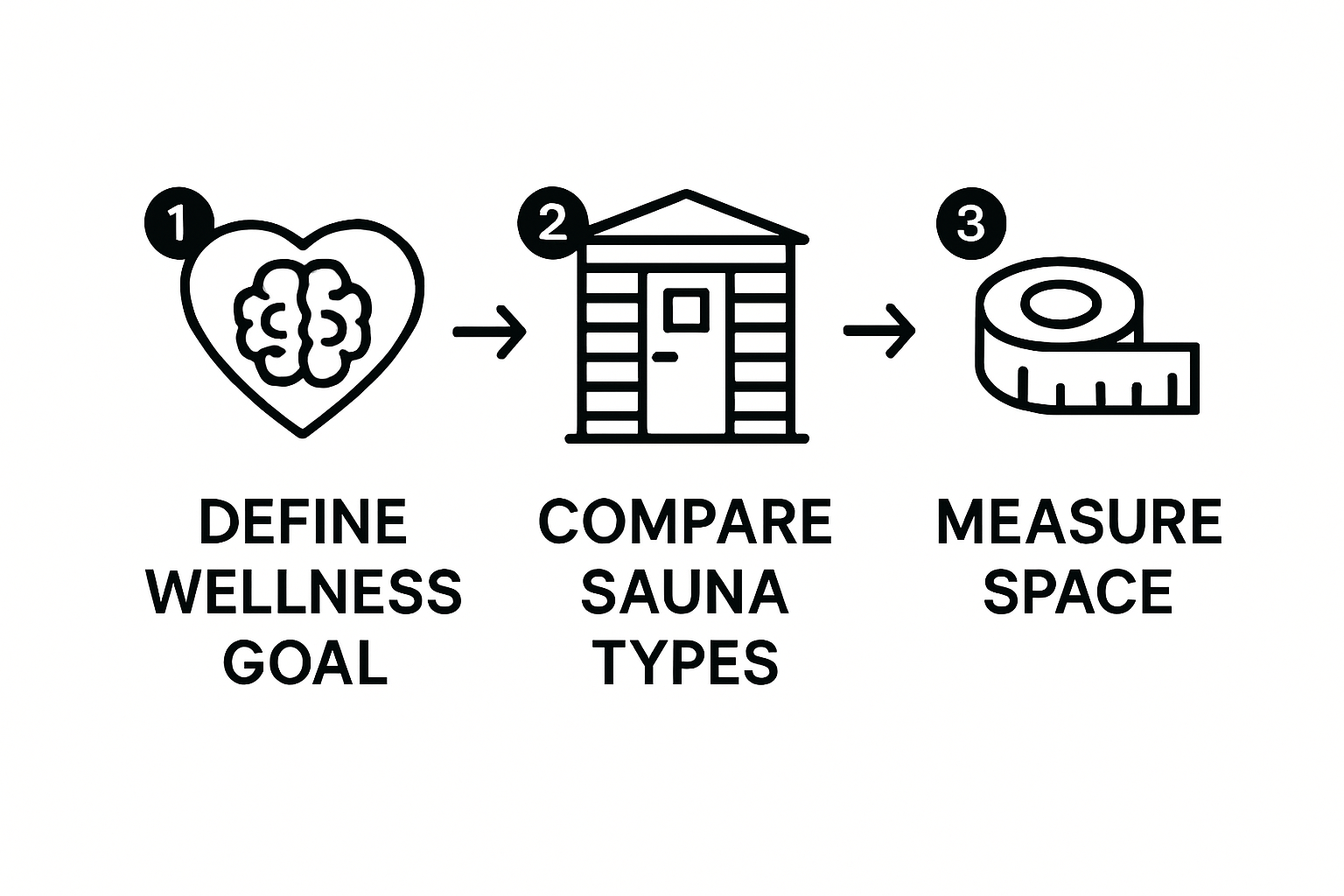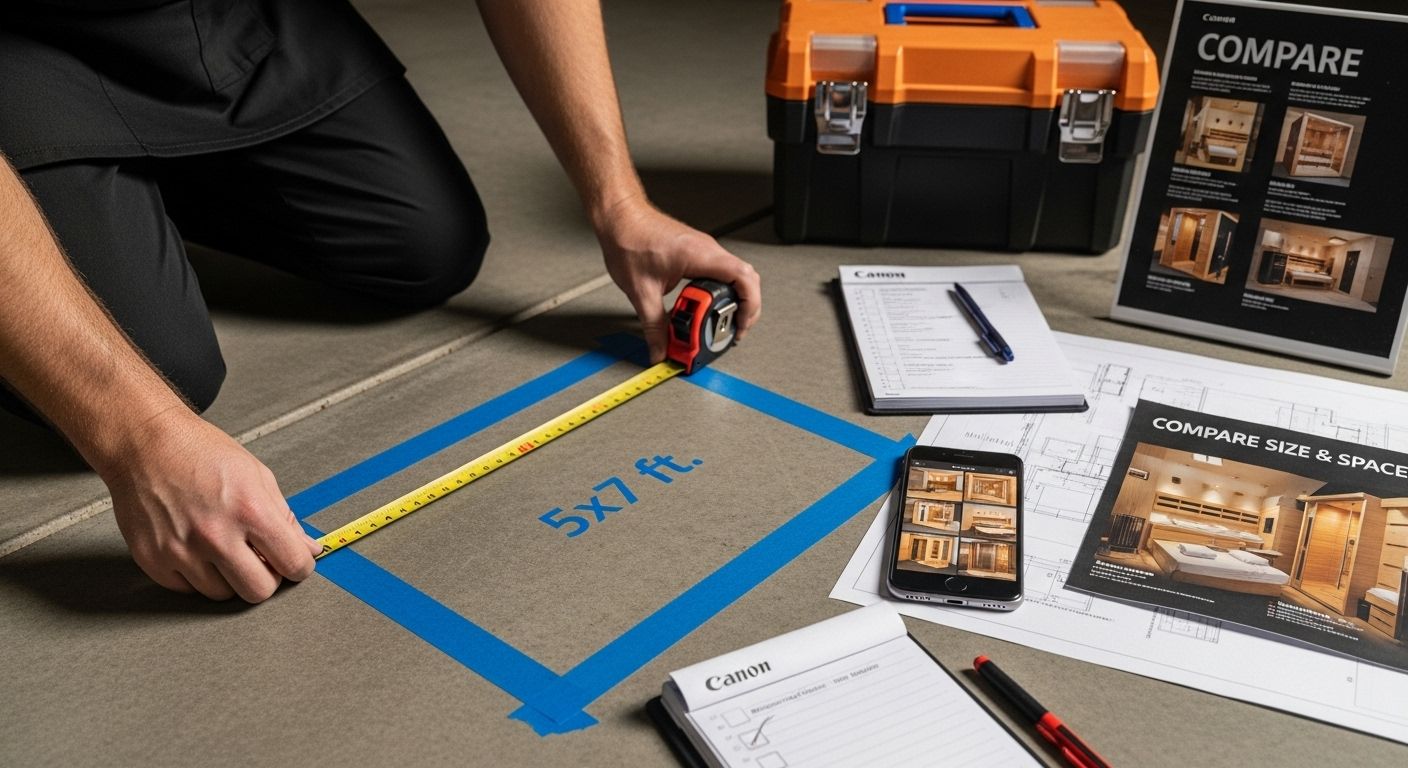
How to Choose Sauna Type: Find Your Perfect Fit

Picking a sauna is about way more than just choosing a place to sweat. Most people jump in without realizing that home saunas can range from $2,000 to over $20,000 and each comes with its own unique health perks. But few realize that matching the right sauna to your specific wellness goals could make all the difference in your results and how you actually feel after every session.
Table of Contents
- Step 1: Evaluate Your Wellness Goals
- Step 2: Research Different Sauna Types
- Step 3: Compare Size And Space Requirements
- Step 4: Determine Your Budget Range
- Step 5: Assist Heating Options And Efficiency
- Step 6: Verify Quality And Warranty Options
Quick Summary
| Key Point | Explanation |
|---|---|
| 1. Defined wellness goals first | Identify your primary reasons for wanting a sauna to ensure it meets your health and relaxation needs. |
| 2. Research sauna types thoroughly | Understand the differences between types of saunas, like infrared and steam, to find the right fit for your wellness goals. |
| 3. Measure available space accurately | Ensure your chosen sauna fits your intended location by measuring dimensions and accounting for necessary ventilation and access. |
| 4. Establish a realistic budget | Consider all costs, including initial purchase and ongoing operational expenses, to make an informed financial decision. |
| 5. Verify quality and warranty options | Assess the construction quality and warranty coverage to ensure your investment is protected and offers long-term satisfaction. |
Step 1: Evaluate Your Wellness Goals
Choosing the right sauna begins with a deep understanding of your personal wellness objectives. Your journey to finding the perfect sauna starts with introspection about what you want to achieve through heat therapy. Each sauna type offers unique benefits, and aligning these with your specific health and wellness goals is crucial for making the most informed decision.
Start by conducting a personal wellness assessment. Consider your primary motivations for seeking a sauna experience. Are you looking to improve cardiovascular health, reduce stress, enhance muscle recovery, or support overall relaxation? According to the Mayo Clinic Proceedings, different sauna modalities can significantly impact various aspects of personal health.
Physical fitness enthusiasts might prioritize muscle recovery and performance enhancement, which could point toward infrared saunas known for deep tissue penetration. Those managing chronic stress or seeking mental wellness might find traditional steam saunas more beneficial for complete relaxation. Individuals with specific health conditions should consult healthcare professionals to understand which sauna type aligns best with their medical needs.
Key wellness goal categories to consider include:
- Stress reduction and mental well-being
- Muscle recovery and athletic performance
- Cardiovascular health improvement
- Detoxification and skin health
- Pain management and inflammation reduction
Take time to reflect on your primary wellness objectives. Honest self-assessment is the foundation of selecting the right sauna. Consider creating a simple pros and cons list for each of your top wellness goals, matching them against different sauna technologies. This methodical approach will help you narrow down your options and ensure your investment supports your long-term health and wellness journey.

Step 2: Research Different Sauna Types
With your wellness goals clarified, the next critical step is diving deep into understanding the diverse world of sauna technologies. Not all saunas are created equal, and each type offers unique characteristics that can dramatically impact your health and relaxation experience. Your research should focus on comprehensively comparing the primary sauna categories to determine which best matches your initial wellness objectives.
Below is a comparison of common sauna types covered in the article, helping you quickly identify key features and how they align with your wellness needs.
| Sauna Type | Heat Source | Typical Temp Range | Humidity Level | Key Benefits |
|---|---|---|---|---|
| Traditional Finnish | Electric/Wood-burning | 150-195°F | Low | Intense sweating, cardiovascular health |
| Infrared | Infrared panels | 120-150°F | Very Low (Dry) | Deep tissue penetration, recovery |
| Steam | Steam generator | 110-120°F | High | Skin health, relaxation |
| Outdoor | Electric/Wood-burning | Varies by type | Varies | Flexible placement, authentic experience |
According to research published in the Mayo Clinic Proceedings, different sauna types produce distinct physiological responses. Traditional Finnish saunas, infrared saunas, steam saunas, and outdoor saunas each provide unique heat exposure and health benefits that require careful evaluation.
Traditional Finnish saunas represent the classic heat therapy experience, characterized by high temperatures and low humidity. These saunas rapidly increase body temperature, promoting intense sweating and cardiovascular stimulation. Infrared saunas, by contrast, use electromagnetic waves to directly heat body tissues, offering a more gentle yet deeply penetrative experience. This makes them particularly attractive for individuals seeking muscle recovery or detoxification.
Key research areas for sauna type comparison include:
- Heat generation mechanism
- Temperature range
- Humidity levels
- Installation requirements
- Energy efficiency
- Potential health benefits
Spend time exploring online resources, reading user reviews, and consulting wellness professionals. Visual comparatives and technical specifications will be your best research tools. Watch demonstration videos, participate in wellness forums, and if possible, schedule test sessions at local wellness centers. Your goal is to transform theoretical knowledge into a tactile understanding of how different sauna technologies feel and function. Remember that your initial wellness goals are the compass guiding this exploration process.
Step 3: Compare Size and Space Requirements
Size and spatial considerations are pivotal when selecting the right sauna. Your available space will significantly influence your sauna type and installation options. Begin by conducting a thorough physical assessment of potential locations, whether that is an indoor bathroom, basement, outdoor deck, or dedicated wellness area.
According to the North American Sauna Society, standard home saunas typically range from 4x6 to 5x7 feet, accommodating two to three people comfortably. Measure your intended installation area carefully, accounting for not just the sauna’s footprint but also surrounding clearance requirements for ventilation, electrical connections, and safe entry and exit.
Indoor saunas demand precise measurements and careful planning. Consider ceiling height, electrical access, proximity to water sources, and potential moisture concerns. Outdoor saunas introduce additional complexity, requiring weather-protection strategies, foundation preparation, and potential permitting requirements. Wooden decks, dedicated backyard spaces, and converted sheds offer excellent outdoor sauna locations.
Key measurement considerations include:
- Interior floor space requirements
- Ceiling height limitations
- Electrical circuit capacity
- Ventilation clearances
- Door swing and entry space
- Proximity to changing areas
Take comprehensive measurements using a professional tape measure, creating a detailed sketch of your potential sauna space. Photograph the area from multiple angles to help visualize potential installation scenarios. If possible, use painter’s tape to outline the sauna’s proposed footprint, helping you understand how the space will be transformed and ensuring the sauna integrates seamlessly with your existing environment.
This checklist table summarizes essential space and installation requirements mentioned in the guide so you can confirm your home is ready for the sauna you choose.
| Requirement | Description | Applies to |
|---|---|---|
| Floor Space | Adequate room for sauna footprint | All sauna types |
| Ceiling Height | Meets sauna height minimums | Indoor installations |
| Electrical Access | Sufficient circuit and outlet availability | Electric/Finnish/Infrared saunas |
| Ventilation Clearance | Area around sauna for air circulation | Indoor/Steam saunas |
| Weather Protection | Foundation and shelter from elements | Outdoor sauna installations |
| Door Swing & Entry Space | Unobstructed door opening and access | All sauna types |

Step 4: Determine Your Budget Range
Budget planning is a critical step in your sauna selection journey, transforming your wellness goals from vision to reality. Your financial investment will directly impact the quality, features, and long-term satisfaction of your sauna experience. Unlike simple purchase decisions, sauna selection requires considering not just upfront costs but ongoing operational expenses.
According to the North American Sauna Society, sauna costs can range dramatically from budget portable units to high-end custom installations. Home saunas typically fall into three primary price categories: entry-level ($2,000-$4,000), mid-range ($4,000-$8,000), and premium ($8,000-$20,000+). Your budget should account for installation, materials, electrical work, and potential home modifications.
Consider your investment as more than a simple purchase. Factor in long-term operational costs, including electricity consumption, maintenance, potential wood treatments, and potential energy efficiency upgrades. Infrared saunas generally consume less electricity compared to traditional Finnish saunas, potentially offering lower ongoing expenses. Outdoor saunas might require additional weatherproofing and structural considerations that increase initial and maintenance costs.
Key budget breakdown elements include:
- Initial equipment purchase price
- Professional installation fees
- Electrical system upgrades
- Potential home renovation costs
- Annual maintenance expenses
- Operational electricity consumption
Develop a comprehensive budget spreadsheet tracking both immediate and projected expenses. Research financing options, including home improvement loans, personal savings, or manufacturer payment plans. Some wellness retailers offer flexible financing that can help distribute the investment over time. Remember that a well-researched, strategically planned sauna purchase is an investment in your long-term health and wellness.
Step 5: Assist Heating Options and Efficiency
Heating technology represents the core functionality of any sauna, transforming your wellness space from a simple room to a transformative health experience. Understanding different heating mechanisms is crucial for selecting a sauna that delivers optimal performance and energy efficiency. Your choice will directly impact both your immediate comfort and long-term operational costs.
According to design research on sauna technologies, heating options range from traditional wood-burning stoves to modern electric and infrared systems. Traditional Finnish saunas typically use wood or electric heaters that warm the air, creating intense heat experiences. Infrared saunas, by contrast, use electromagnetic waves to directly warm body tissues, operating at lower temperatures while providing deep heat penetration.
Electric heaters offer precise temperature control and consistent performance, making them ideal for indoor installations with reliable electrical infrastructure. Wood-burning stoves provide a more authentic experience, delivering rich ambient heat and a classic sauna atmosphere. Infrared panels represent the most energy-efficient option, consuming less electricity while offering more focused therapeutic heating.
Key heating efficiency considerations include:
- Initial equipment cost
- Electricity consumption rates
- Heat distribution technology
- Installation complexity
- Maintenance requirements
- Environmental impact
Consult with heating specialists to understand the nuanced performance characteristics of each technology. Create a comparative spreadsheet tracking energy consumption, installation costs, and long-term operational expenses. Some modern saunas even integrate smart technology, allowing remote temperature control and energy monitoring. Your goal is to find a heating system that balances performance, efficiency, and your specific wellness objectives.
Step 6: Verify Quality and Warranty Options
Quality verification represents the final critical checkpoint in your sauna selection journey. Your investment deserves comprehensive protection and assurance of exceptional craftsmanship. This step goes beyond surface-level assessments, requiring a meticulous examination of construction materials, manufacturing standards, and long-term support mechanisms.
According to the International Association of Certified Home Inspector’s guidelines, premium saunas should utilize decay-resistance woods like cedar, redwood, or Nordic spruce. Inspect potential saunas for precise construction details such as tight wood joints, smooth interior surfaces, proper ventilation design, and robust electrical components. Look for manufacturers who provide transparent documentation about their production processes and material sourcing.
Warranty coverage is your financial safety net. A comprehensive warranty reflects manufacturer confidence in their product. Ideal warranty packages should include protection for structural components, electrical systems, and heating elements. Request detailed warranty documentation, paying close attention to coverage duration, what specific components are protected, and any potential exclusions or maintenance requirements that might void the warranty.
Key quality verification criteria include:
- Material durability and wood quality
- Precise construction techniques
- Electrical system reliability
- Heating element performance
- Comprehensive warranty coverage
- Manufacturer reputation and customer support
Develop a systematic evaluation approach. Request multiple documentation sets from potential manufacturers, compare warranty terms side by side, and don’t hesitate to ask probing questions about long-term product support. Your thorough investigation now can prevent potential disappointments and unexpected expenses in the future. Remember, a high-quality sauna is more than a purchase—it’s an investment in your wellness journey.
Discover Your Perfect Sauna Match – Start Your Wellness Journey with Best Life Sauna
If you are feeling lost trying to balance your wellness goals with complicated sauna options, you are not alone. The article highlights how many people struggle with choosing between traditional, infrared, or outdoor models, and the stress that comes with space limitations, budget decisions, and quality concerns. At Best Life Sauna, we understand these pain points. We offer a wide variety of high-quality saunas and wellness products designed to fit your needs, whether stress relief, muscle recovery, or at-home luxury is your top priority. Our team is dedicated to guiding you step by step so you can avoid costly mistakes and find the sauna that truly matches your lifestyle.

Ready to turn your dream sauna experience into a reality? Explore our premium selections and enjoy exclusive offers like free shipping on orders over $200. See real customer reviews and discover the benefits our products provide. Take action now and visit Best Life Sauna to find your ideal sauna and start seeing results. Your perfect fit is just one click away.
Frequently Asked Questions
What factors should I consider when choosing a sauna type?
When selecting a sauna type, evaluate your wellness goals, such as stress reduction, muscle recovery, or cardiovascular health. Research different sauna types and their unique benefits, space requirements, budget, heating options, and quality assurance.
How do traditional saunas differ from infrared saunas?
Traditional saunas use high temperatures and low humidity to create intense heat, primarily heating the air. In contrast, infrared saunas utilize electromagnetic waves to directly heat the body at lower temperatures, promoting deep tissue relaxation and recovery.
What are the space requirements for different sauna types?
Space requirements vary: traditional saunas generally need more room for steam and ventilation, while infrared saunas are often more compact. Ensure your installation area is measured accurately, considering door clearance and access for maintenance.
How do I budget for a sauna purchase?
Budgeting for a sauna involves considering the initial purchase price, installation costs, and ongoing operational expenses like electricity. Prices can range from entry-level ($2,000-$4,000) to premium models ($8,000-$20,000+), so assess what features are essential for your wellness goals.

